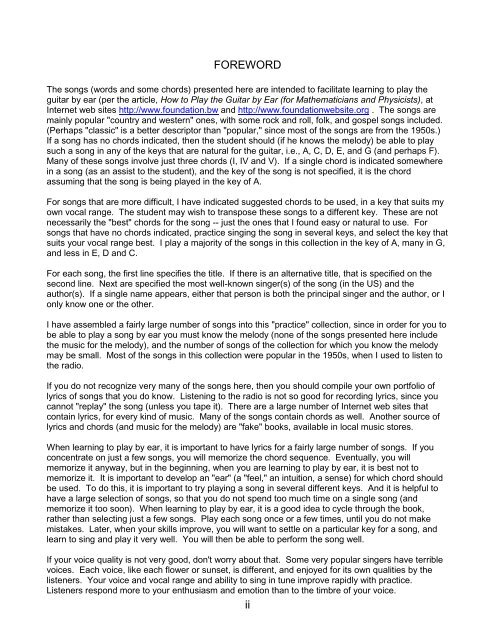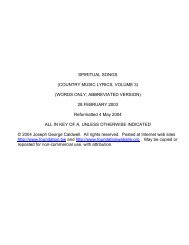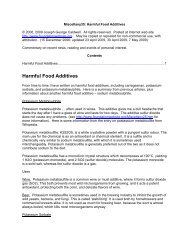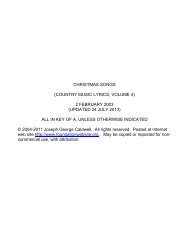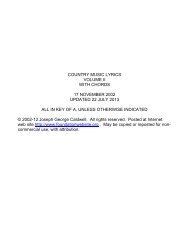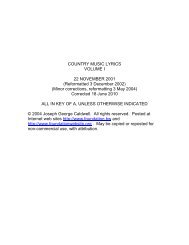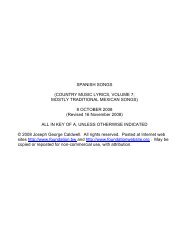Country Music Lyrics Volume 1 with Chords - Foundationwebsite.org
Country Music Lyrics Volume 1 with Chords - Foundationwebsite.org
Country Music Lyrics Volume 1 with Chords - Foundationwebsite.org
Create successful ePaper yourself
Turn your PDF publications into a flip-book with our unique Google optimized e-Paper software.
FOREWORD<br />
The songs (words and some chords) presented here are intended to facilitate learning to play the<br />
guitar by ear (per the article, How to Play the Guitar by Ear (for Mathematicians and Physicists), at<br />
Internet web sites http://www.foundation.bw and http://www.foundationwebsite.<strong>org</strong> . The songs are<br />
mainly popular "country and western" ones, <strong>with</strong> some rock and roll, folk, and gospel songs included.<br />
(Perhaps "classic" is a better descriptor than "popular," since most of the songs are from the 1950s.)<br />
If a song has no chords indicated, then the student should (if he knows the melody) be able to play<br />
such a song in any of the keys that are natural for the guitar, i.e., A, C, D, E, and G (and perhaps F).<br />
Many of these songs involve just three chords (I, IV and V). If a single chord is indicated somewhere<br />
in a song (as an assist to the student), and the key of the song is not specified, it is the chord<br />
assuming that the song is being played in the key of A.<br />
For songs that are more difficult, I have indicated suggested chords to be used, in a key that suits my<br />
own vocal range. The student may wish to transpose these songs to a different key. These are not<br />
necessarily the "best" chords for the song -- just the ones that I found easy or natural to use. For<br />
songs that have no chords indicated, practice singing the song in several keys, and select the key that<br />
suits your vocal range best. I play a majority of the songs in this collection in the key of A, many in G,<br />
and less in E, D and C.<br />
For each song, the first line specifies the title. If there is an alternative title, that is specified on the<br />
second line. Next are specified the most well-known singer(s) of the song (in the US) and the<br />
author(s). If a single name appears, either that person is both the principal singer and the author, or I<br />
only know one or the other.<br />
I have assembled a fairly large number of songs into this "practice" collection, since in order for you to<br />
be able to play a song by ear you must know the melody (none of the songs presented here include<br />
the music for the melody), and the number of songs of the collection for which you know the melody<br />
may be small. Most of the songs in this collection were popular in the 1950s, when I used to listen to<br />
the radio.<br />
If you do not recognize very many of the songs here, then you should compile your own portfolio of<br />
lyrics of songs that you do know. Listening to the radio is not so good for recording lyrics, since you<br />
cannot "replay" the song (unless you tape it). There are a large number of Internet web sites that<br />
contain lyrics, for every kind of music. Many of the songs contain chords as well. Another source of<br />
lyrics and chords (and music for the melody) are "fake" books, available in local music stores.<br />
When learning to play by ear, it is important to have lyrics for a fairly large number of songs. If you<br />
concentrate on just a few songs, you will memorize the chord sequence. Eventually, you will<br />
memorize it anyway, but in the beginning, when you are learning to play by ear, it is best not to<br />
memorize it. It is important to develop an "ear" (a "feel," an intuition, a sense) for which chord should<br />
be used. To do this, it is important to try playing a song in several different keys. And it is helpful to<br />
have a large selection of songs, so that you do not spend too much time on a single song (and<br />
memorize it too soon). When learning to play by ear, it is a good idea to cycle through the book,<br />
rather than selecting just a few songs. Play each song once or a few times, until you do not make<br />
mistakes. Later, when your skills improve, you will want to settle on a particular key for a song, and<br />
learn to sing and play it very well. You will then be able to perform the song well.<br />
If your voice quality is not very good, don't worry about that. Some very popular singers have terrible<br />
voices. Each voice, like each flower or sunset, is different, and enjoyed for its own qualities by the<br />
listeners. Your voice and vocal range and ability to sing in tune improve rapidly <strong>with</strong> practice.<br />
Listeners respond more to your enthusiasm and emotion than to the timbre of your voice.<br />
ii


